July 5, 2006 – Bako National Park
Suhigh (AKA Sam), our guide, met us in the hotel lobby after breakfast. We drove about 45 minutes in the countryside outside Kuching to a little town where we boarded a speedboat. The boat driver posed for several photos as we headed out the river and into the South China Sea. The area reminds me so much of Thailand with its mangroves, lush vegetation, sculptured cliffs, and beautiful clear water. We saw a few fishermen out in their boats and evidence of lots of fishing nets.
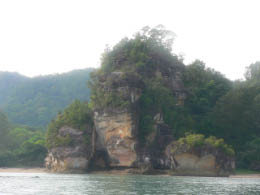
Bako National Park |
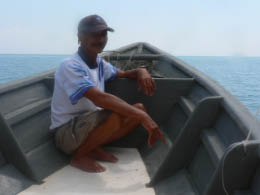
Our boat driver |
We docked at a beach and headed toward the park headquarters. Along the way a troop of very naughty long-tailed Macaque monkeys approached us, making scary noises. They seemed particularly interested in Terry. Our guide, Sam, warned us, “No eye contact with the monkeys.” Later, while we waited for Sam to register us at the park, a troop of Silver Leaf monkeys entertained us with their antics in large trees by the shore. The dominant male made sure we cleared out of the way before his family climbed on a branch overhead. You don’t mess around with these monkeys.
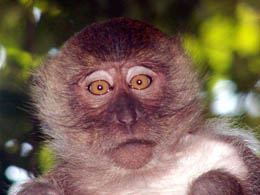
Macaque |
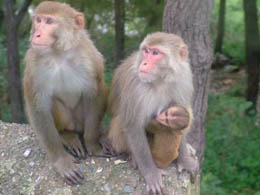
Macaque Family |
Sam took us back into some trees next to the park headquarters. He gently pulled back a limb for us to view a deadly little pit viper resting among the leaves. Sam said the viper been resting there for a couple days, probably still digesting his last meal. He told us that a pit viper senses his potential victim’s body heat through a pit in his head and follows that heat for his next meal. Sam assured us that the viper wasn’t interested in us – because of our body heat the snake would realize that we were too large to swallow.
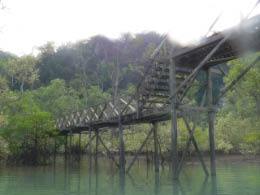
Bako National Park |
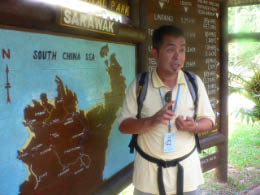
Suhigh, our guide at Bako |
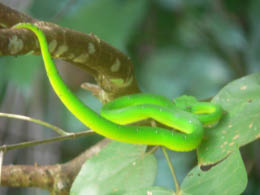
Pit Viper |
On the way to the start of the jungle hike, we spotted one large proboscis monkey eating his breakfast in the trees. Proboscis monkeys are famous for their huge noses and potbellies and have been called “Dutchmen” by the locals for centuries. They are only found in Borneo and only in coastal swamp forests and forests next to rivers. This fella was very mellow and looked a lot like Jimmy Durante.
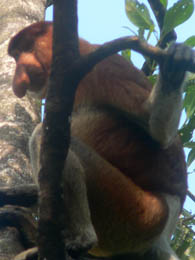
Proboscis Monkey |

Is there a family resemblance? |
There was a huge crowd of tourists at the start of the jungle trail, but most of them turned back, so we had the trail to ourselves (guided by Sam, of course).
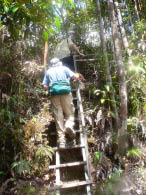
Rain forest trail |
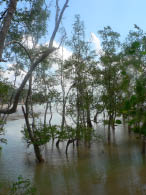
Mangrove Swamp |
The trail ended at a beach where we waited for a boat to pick us up. We sat among some strong, young local guys who were probably boat drivers and park guides. They were talking, laughing and smoking cigarettes while coordinating their daily schedules on their cell phones. Smoking is very big here – very macho.
We waded through the water to board our boat at 11:00.
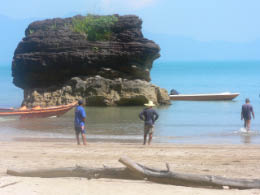
Waiting for our boat |
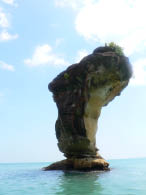
Sea Stack |
We passed by the “Sea Stack,” a mini island right off the coast.
Our driver stopped our boat in shallow waters at another beach. We waded to the shoreline and followed a riverbank accented with wild flowers.
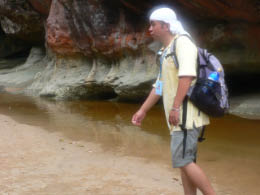
Suhigh |
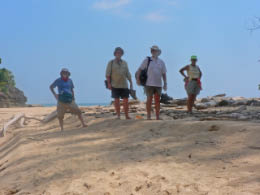
Heading toward the River Trail |
Next we headed straight up some very rickety steps to a large lava rock for a grand view of the coastline below.
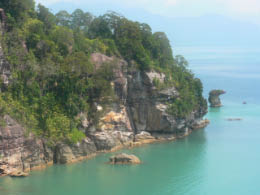
Bako cliffs on South China Sea |
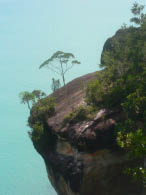
Nice view |
I loved the two-hour jungle hike that followed. The sounds of birds and insects were wonderful background music to our ears. Pitcher plants, all sizes and varieties, hung from vines or sat on the ground – absolutely amazing to me. I couldn’t control my shutter finger and was always the last one on the trail.
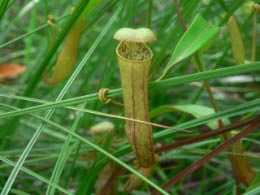
Pitcher Plant |
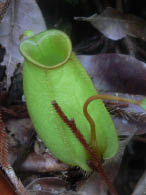
Pitcher plant |
The changes in our footpath intrigued me. Sometimes we walked on suspended bridges, sometimes on large protruding roots, sometimes over hard lava, sometimes in stream beds or sometimes in the soft jungle mush. You don’t get these kinds of hikes in San Diego.
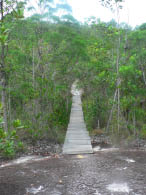 Rain forest trail Rain forest trail |
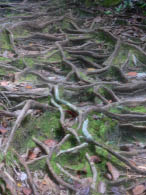 Roots on Trail Roots on Trail |
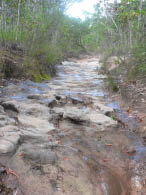 Stream bed Stream bed |
We were within 15 minutes of the cafeteria when Bev felt faint with a fever. She made it to the cafeteria for a lunch. We didn’t expect much in that isolated park with no cars or trucks to bring in the goods, and we were right. I gobbled up the rice and noodles and stayed away from the dishes that are unrecognizable.
After lunch, I went for a walk along the seashore – just me and my camera. There I was treated to nature’s modern art gallery that hung just below the cliffs – and admission was free!
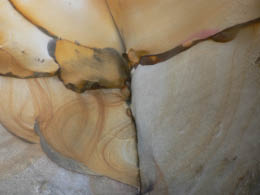
Cliff side"Art" |
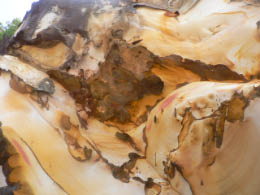
Cliff side"Art" |
Around 3:00 we boarded our speedboat and returned to the village where we had started earlier in the morning. We quickly found a local dive and had a round of Tiger beer while Bev sipped on her Diet Coke.
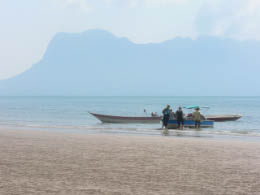
Returning to "civilization" |
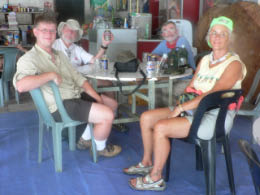
Tiger time |
The little village was pretty much a shantytown. We had a great vantage point to observe life in the town from that bar overlooking the meandering river that ran through the town.
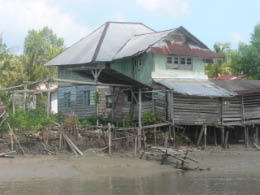
Riverside shack |
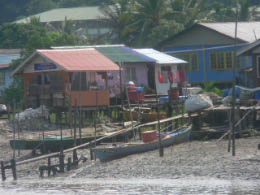
The pier |
Back in Kuching, the boys and I headed back to James Brooke, our joint on the waterfront, for another Tiger beer.
Later, at the hotel, we showered and got ready for a group dinner. We loaded on the bus, but just before we left, Bev wasn’t feeling well and decided to return to her room. We ate at Benson Seafood, a local outdoor restaurant. The dinner was typical lazy Susan tour group fare, but the company was delightful. Terry, Jaime, Bill, Bob and Diana (from California – She’s a teacher / He collects blowguns), and Judy and Rick (from Boston – fun loving cool people). Both couples travel extensively and were very interesting. Sorry I missed a lot of the conversation over that big round table in a noisy atmosphere.
We came back to the hotel and repacked our bags for a two-night stay at Batang Ai.
July 6, 2006 – Kuching to Batang Ai
After our big buffet breakfast at the hotel, we boarded the bus for the 5-hour drive to Batang Ai. I enjoyed the information Thomas and Rives (our local guide) shared with us on the bus and at the stops we made along the way. They both have so much knowledge and such cute personalities.
Rives’ Report – An Overview:
The number one government budget priority in Malaysia is education. Second is health care. The government does not have a program for the elderly because the families take care of their parents and grandparents. It is considered shameful not to. Thomas said his father doesn’t eat much, so why not have him around the house to get to know his grandchildren. If he gets bored, he just goes to another one of his children’s homes.
The year 2020 is the target date for every family in Malaysia to have a house. The government has a plan to subsidize housing according to income. Affordable housing is going up everywhere. The government leases the houses for 99 years. The policy is causing some issues with the people.
Cars are very expensive. A little compact car costs $15,000 (with a 300% tax – ouch!). Most cars are Japanese (Nissan, Toyota, Honda). There are a lot of Ford 4-wheel drive vehicles. The Proton is their local car manufacturer and their first national car project.
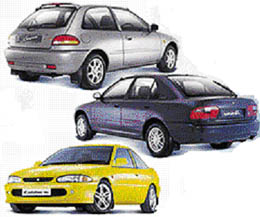
Malaysian-made Protons |
They have a very young population with a median age of 24 (1/3 are ages 0-14; 2/3 are ages 15-64; and less than 5% - 65 or older).
The birth rate is very low – in fact, the government is encouraging more babies.
The ethnic group breakout is: 50% Malay, 25% Chinese, 10% Indigenous, 7%, Indian, 8% others.
The religions practiced in Malaysia are Muslim, Buddhist, Taoist, Hindu, Christian, and some Shamanism still practiced in Borneo.
They have a very low unemployment rate – 3%. In fact, in Borneo, the Indonesians are welcomed to Sarawak do the cheap labor that most Malaysians don’t want to do.
The states of Sarawak and Sabah are defined not by rivers, but by watershed lines (mountain ridges). By using natural markings, there are fewer land disputes. Rives pointed out that Indonesia was just over a mountain. One road that goes over the mountain and into Indonesian has an open entry point – no passports required – no walls or fences going up here!
Government is a constitutional monarchy - headed by paramount ruler and a bicameral parliament (non elected upper house and an elected lower house). A federal constitution limits the state governments.
(NOTE: All Peninsular Malaysian states have hereditary rulers except Malacca and Penang; those two states along with Sabah and Sarawak in East Malaysia have governors appointed by government.)
There are 13 states, with their federal capital in Kuala Lumpur. They gained independence from UK on August 31, 1957. Wonder if they celebrate with hot dogs and fireworks?
The flag was modeled after the U.S. flag with 14 red and white stripes representing the 13 states plus the federal government. The gold crescent and star are symbols of Islam, and the blue field represents the unity of the people.

Malaysian Flag |
|
The first several towns on the main road are named by their distance from Kuching -- 1-mile town, 2-mile town, etc. Rives lives in 10-mile town, a pretty nondescript place.
The roads were good with little traffic – it’s no wonder with car prices like they are. Our driver, Mr. Young (and all the rest of the drivers we had on the trip), was courteous and safe. There was very little horn honking from these peaceful, mellow people. (In fact, people who display aggression and anger are looked down upon. In our country that type of behavior is usually rewarded. I have several ex-bosses as prime examples.)
Our first stop was at the town of Serian known for its durian – a most awful smelling fruit. (People say it tastes like heaven, but smells like hell.)
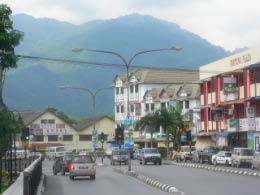
Serian Town |
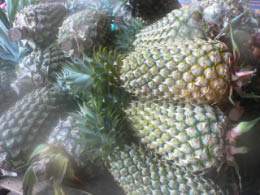
Pineapples |
We visited the huge, colorful market and were fascinated by the jungle produce, the unusual tropical fruit, the baked goods, the meat and fish counters and the poor, tired farmers who got up so early and had to travel so far to sell their goods.
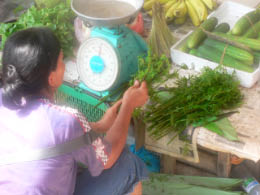
Serian Market |
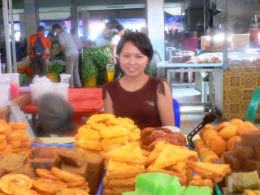
Serian Market |
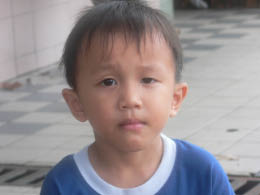
Boy at the Market
|
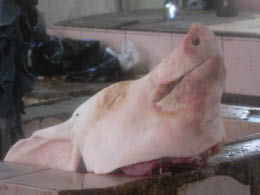
I may never eat pork again |
Our next stop was the pepper farm. We saw pepper plants growing up hardwood stakes evenly distributed over the fields. From a distance, the fields looked like one of our Californian vineyards. Black pepper is made from the small, dark, unripe fruit (peppercorns) and white pepper (much more expensive) is produced from the ripened red fruit.
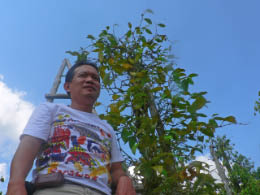
Rives under a pepper tree |
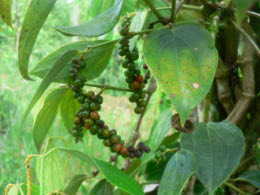
Peppercorns |
Rives said the bottom had fallen out of the pepper market. To add salt (or is it pepper?) to the wound, fertilizer prices have shot up. Farmers are abandoning their pepper plants for palm oil trees and rubber plants. The government may have to subsidize the pepper business to keep it in Malaysia.
The bus pulled off the road and Thomas jumped out to scout the area for wild orchids. I thought to myself how could beautiful, delicate orchids possibly be growing in that hot, miserable looking lot? Never judge a book by its cover. Upon closer examination, we saw amazing wild bamboo orchids growing in patches of reeds and large pitcher plants perched on the scorched ground. There are 25,000 different species of orchids that bloom in the wild. One orchid can cost up to $7,000. Orchids only bloom one to seven times in their lifetime and to think we saw all those lovely orchids by the side of the road.
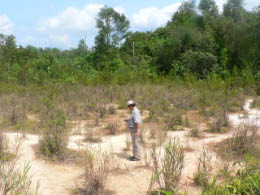
A baron spot for orchids |
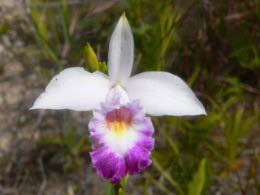
Orchid by side of road |
I observed two insects mating on a soft orchid petal. I didn’t want to leave that vacant lot with all its discoveries to behold.
Back on the bus, Thomas and Rives continue their “show and tell,” sharing fruit they had purchased at the market:
- Snake skin fruit – a tropical fruit with a leathery, brown snake-like skin, covering a small lobe that you eat. It has a hint of citrus, but not very juicy – I didn’t like it, but I’m a picky eater.
- Ginger – the flower is used for Tom Yum soup. There are 4 different types of root. Women who are engaged rub the yellow root on their hands and fingers to indicate they are off-limits.
- A long bean that grows in vines on trees. Thomas said the bean inside the pod is good for the kidney. Thomas and Rives tricked us into eating one pod each. It tasted so garlicky and gave me a stomach ache– you bad boys!
- Rivers explained how the pitcher plant works – with its trap at the top, sticky section in the center and digestive juices at the bottom. Monkeys drink the juice and appear to get drunk. Mothers give it as medication to their kids who are acting psychotic.
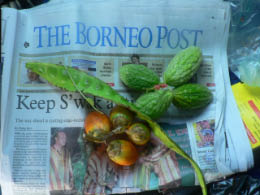
Exotic fruit from the market |
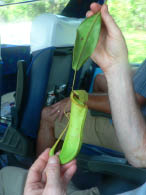
Pitcher Plant |
We stopped for lunch and bathroom break. The food was good. However I made the mistake of going into the kitchen and saw sweaty cooks bent over hot steaming woks – That’s life in the 3rd World.
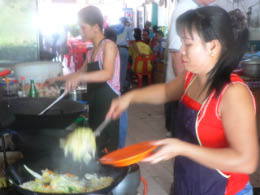
Cooking our lunch |
Near the end of our bus ride, we passed by a dam and reservoir. The area contains the Batang Ai River and its tributaries (including the Engkari and Delok), which feed a massive lake formed by the Batang Ai Hydro-Electric Dam. The huge hydroelectric project, completed in the 1980’s, was expected to cost 17 billion ringgets ($5 billion – US) with plans to pipe extra power to the Philippines and to the mainland.
Even though the project was scaled back, the government still managed to displace over 40,000 native Ibans with their traditional longhouse neighborhoods and their well-preserved customs and lifestyle. It’s a very big issue because of the empty promises and lack of government compensation.
Iban Side notes:
We were in Iban country-- the ancestral home of the Iban in Sarawak. After decades of strong resistance by native Ibans, Batang Ai was the last area in Sarawak to come under the control of the White Rajahs.
The Iban, largest ethnic group in Sarawak, were also known as Sea Dayaks. Formerly warlike and expansionist, Ibans were famous pirates and headhunters.
Their traditional lifestyle is based on cultivation of dry rice. The rice planting and harvesting cycle are also the focus of their belief system. Although the majority of Ibans converted to Christianity, rice still plays a powerful social and spiritual role. Today, many Ibans grow cash crops such as pepper, rubber, cocoa and oil palm, as well as hill rice. Many others live in Sarawak's town and cities, but maintain strong ties to their ancestral longhouses. |
Finally, after a long day’s drive, we arrived at the dock and waited for the boat to take us to the Hilton Longhouse Resort in Batang Ai.
The Hilton Longhouse, a luxury resort, is the only place to stay for miles around, unless of course, you’re lucky enough to get invited to real longhouse with an authentic Iban tribe. During the 15-minute boat ride, I chatted with Alex and Jimmie and learned about their work as hospice care workers. Once in a while I got a peak at the incredible surroundings from the boat – green, peaceful, lush, scenic – that’s enough adjectives.
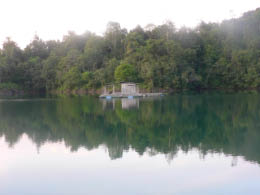
On the way to the Hilton Longhouse |
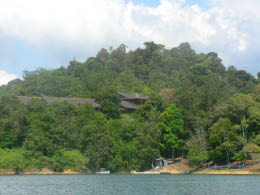
Our first view of the Hilton Longhouse |
The Hilton Longhouse is truly a paradise. We climbed the steps from the dock and walked through the lobby and the beautifully landscaped grounds. (Swallows made their nests in the eaves of the large, open entrance area.)
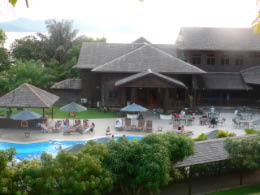
The Hilton pool |
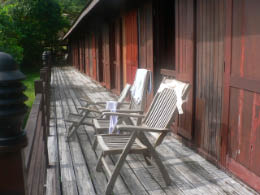
The Veranda |
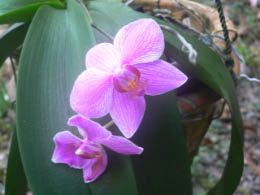
Hilton Orchids |
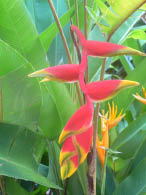
Firecracker Flowers |
Then came time for a jug of Tiger beer with Terry and Jamie on the veranda. Others joined us – what a great tour group! The beer tasted great – but was very pricey. It’s not easy getting Tigers up the river and adequately chilled.
While the others ordered another jug, I took a walk by myself in search of the best sunset picture ever. I wandered past the “no entrance” signs and saw the staff’s quarters and other facilities required to support such a huge resort operation.
The sunset was magnificent.
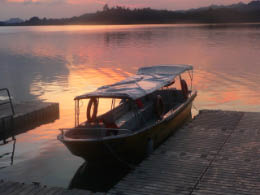
Sunset on Lake Batang Ai |
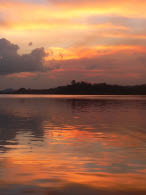
Sunset |
We had dinner at the lodge. The food was great – especially the roast lamb and the ice cream sundaes.
We went back to our room, the last room in Longhouse #5. Bill still had some energy left so he and Jaime went for an evening program and watched a video on the Orangutan Rehab Center that we’ll be visiting later in the trip.
Bill got back at 9:30 and it was lights out for us. |











